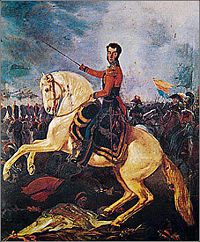Bolivian War of Independence
| Bolivian War of Independence | |||||||
|---|---|---|---|---|---|---|---|
| Part of Spanish American wars of independence | |||||||
 |
|||||||
|
|||||||
| Belligerents | |||||||
|
|
|||||||
The Bolivian war of independence began in 1809 with the establishment of government juntas in Sucre and La Paz, after the Chuquisaca Revolution and La Paz revolution. These Juntas were defeated shortly after, and the cities fell again under Spanish control. The May Revolution of 1810 ousted the viceroy in Buenos Aires, which established its own junta. Buenos Aires sent three military campaigns to the Charcas, headed by Juan José Castelli, Manuel Belgrano and José Rondeau, but the royalists ultimately prevailed over each one. However, the conflict grew into a guerrilla war, the War of the Republiquetas, preventing the royalists from strengthening their presence. After Simón Bolívar and Antonio José de Sucre defeated the royalists in northern South America, Sucre led a campaign that was to defeat the royalists in Charcas for good when the last royalist general, Pedro Antonio Olañeta, suffered death and defeat at the hands of his own defected forces at the battle of Tumusla. Bolivian independence was proclaimed on August 6 of 1825.
Charcas (modern day Bolivia) is also sometimes referred to as the Upper Peru. This region fell under the authority of Spanish colonial rule in the sixteenth century. It was originally placed directly under the rule of the Viceroyalty of Peru, however this location proved to be too distant for effective ruling so Phillip II established the Audiencia of Charcas , which was an autonomous governing body under the purview of the viceroy of Peru. This governing was composed of oidores or judges and a governor with the title of president of the Audiencia. The Audiencia was given authority to make final decisions when a viceroy was unavailable or absent. The Audiencia was centered in Chuquisaca, which started out as an indigenous community and later became known by its post-independence name, Sucre. This was the center of administration as well as cultural activities for Charcas. The Archbishop of Charcas lived there and one of the prominent universities in Bolivia, was founded there. The Audiencia was a great honor for the Charcas.Oidores mostly came directly from Spain and tended to be very proud, often making everyone bow to them. They were also incredibly ignorant about the peoples needs and problems. As Spanish settlements expanded to the south, the jurisdiction of the Audiencia of Charcas grew to include not only present day Bolivia, but also Argentina, Uruguay, Paraguay and even parts of Peru. In 1776, the Audiencia of Charcas was placed under the authority of the viceroy of Buenos Aires in the newly created Viceroyalty of the Río de la Plata and most trade was redirected to Buenos Aires. This change was against Peruvian desires because they had wanted to keep Charcas for its enormous wealth in the mines of Potosí. For the next few decades, the question of the political and economic ties with Charcas was constantly fought over by Peru and Río de la Plata. On May 25, 1809 the citizens of Sucre participated in the first outbreak that was part of the initiation of the war of independence in Bolivia.
...
Wikipedia
